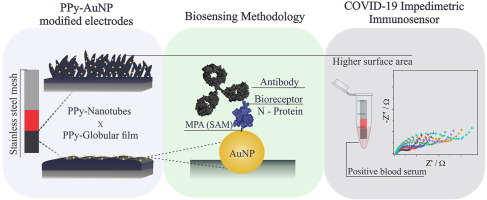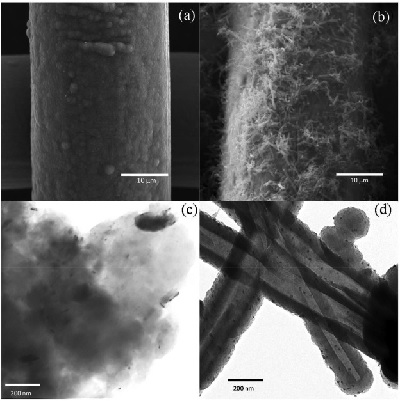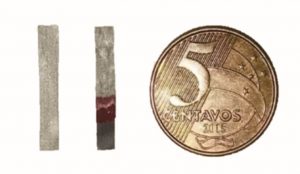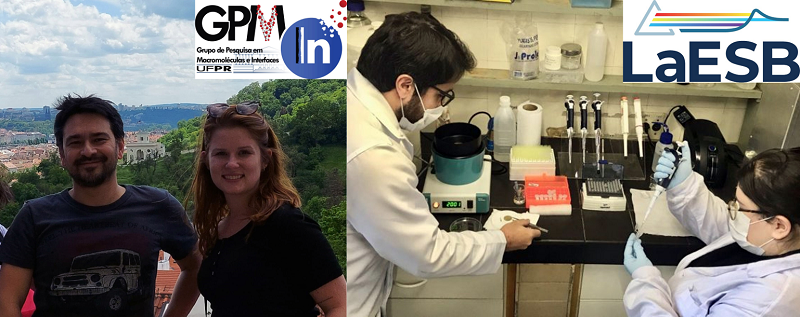
A team of researchers from the Brazilian Federal University of Paraná (UFPR) has developed a low-cost biosensor capable of detecting Covid-19 antibodies in about 30 minutes and with high sensitivity. The system has shown promise for producing handheld, disposable devices that could be used to diagnose coronavirus infection or to confirm antibody production after vaccination using just a few drops of blood.
Biosensors are systems that have a biological element (in this case, the N protein of the SARS-CoV-2 virus) responsible for chemically interacting with what you want to detect (in this case, the specific antibody for that antigen). When the interaction takes place, the chemical reaction is transformed in the device into an interpretable signal.
The biosensor developed at UFPR is based on a stainless steel mesh coated with a hybrid material which is formed by a polymer that conducts electricity (polypyrrole) and gold nanoparticles. In these nanoparticles, virus proteins are immobilized, so that antibodies from blood samples, if any, come into contact with their antigens, spontaneously react with them and become detectable.
Facing the pandemic
The idea of the research emerged at the beginning of the Covid-19 pandemic, when society needed to have systems for the detection of the virus and the antibodies generated by the infection. At that moment, Professors Dênio Souto and Marcio Vidotti, from UFPR, decided to gather their expertises in sensors and related topics and be part of the global efforts.
“We already knew from the beginning that the urgency and multidisciplinary nature of the subject would increase our challenge”, says Bruna M. Hryniewicz, first author of the article that reports this research in the journal Materials Today Chemistry. Bruna took part in the research during her PhD, still in progress, under the guidance of Professor Vidotti, both from the Research Group on Macromolecules and Interfaces at UFPR.
A detection system was built based on the doctoral thesis of Ana Leticia Soares, which has just been defended by UFPR. With the guidance of professors Marcio Vidotti and Luis Fernando Marches, the work resulted in a platform formed by a conductive polymer modified with gold nanoparticles that showed promising responses when joined to several pairs of antigens and antibodies.
More sensitivity and selectivity

Starting from this platform, the team investigated some issues that could improve the sensitivity and selectivity of the biosensor – parameters that allow reducing the amount of false positives and negatives in the detection results, even in small amounts of sample.
In this sense, the authors synthesized and characterized two polypyrrole morphologies to produce the hybrid material, the globular and the nanotubular, and found that the polymeric nanotube biosensor had a sensitivity eight times higher to detect antibodies than the globular polypyrrole system.
Another important point was the choice of the method of immobilization of the N protein in the nanoparticles. The researchers chose to promote a covalent bond (chemical bond based on the sharing of electron pairs between the atoms involved), which brings more stability and sensitivity to the system. In fact, this methodology positions the antigen in an orientation in which the sites of interaction with the antibody are available – an interaction that is further encouraged by the favorable chemical environment provided by polypyrrole. “All these characteristics allow the biosensor to present satisfactory sensitivity and selectivity responses”, says Jaqueline Volpe, also the first author of the article, who participated in the research during her master’s degree, under the guidance of Professor Dênio Souto, both from the Spectrometry, Sensors and Biosensors.
In addition to the participation of professors, post-docs and students from the Graduate Program in Chemistry at UFPR, the collaboration of researchers and physicians from UFPR and Hospital Erasto Gaertner, in Curitiba, was fundamental in the research. These collaborators quickly provided the SARS-CoV-2 N protein. They also obtained blood samples from people with and without Covid-19 who had had PCR tests (the diagnostic methodology considered the most accurate), which were used to test the performance of the biosensor.
“Taking into account that the work was carried out during the height of the pandemic, the challenges were numerous, from access to laboratories, to the exploration of a highly relevant topic, which generates greater pressure in the development of research”, comments Larissa Bach Toledo, co-author of the article.

According to the authors, the biosensor developed is promising for use on a large scale in the diagnosis of infected people and in the monitoring of antibodies due to the simple and scalable method of manufacturing the electrodes (batch synthesis), added to the low cost of the stainless steel matrix, and the high sensitivity of the system. However, to produce it commercially, it would be necessary to do many more validation tests with real samples, as well as transforming the system into a simple, miniaturized and easy to use device, in which the detection results could be interpreted by anyone.
This research was funded by the German foundation Alexander von Humboldt, UFPR through Proind 2020 and the Brazilian agencies CAPES and CNPq. The work also received support from INCTBio, of which Professor Marcio Vidotti is a member.

Reference of the paper: Development of polypyrrole (nano)structures decorated with gold nanoparticles toward immunosensing for COVID-19 serological diagnosis. B. M. Hryniewicz, J. Volpe, L. Bach-Toledo, K. C. Kurpel, A. E. Deller, A. L. Soares, J. M. Nardin, L. F. Marchesi, F. F. Simas, C. C. Oliveira, L. Huergo, D. E. P. Souto, M. Vidotti. Materials Today Chemistry. Volume 24, June 2022, 100817. https://doi.org/10.1016/j.mtchem.2022.100817.
Contact of the corresponding authors: denio.souto@ufpr.br and mvidotti@ufpr.br.

Armando massatoshi Miyata
Muito orgulhoso de todos os pesquisadores.